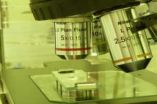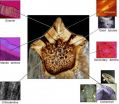(Press-News.org) As restaurant patrons' diverse food preferences give rise to varied menu offerings, so plant-eating insects' preferences play an important role in maintaining and shaping the genetic variation of their host plants in a geographic area, reports an international team of researchers that includes a plant scientist at the University of California, Davis.
The new study, involving aphids and the broccoli-like research plant Arabidopsis thaliana, provides the first measureable evidence that this selective process is driven, in part, by the pressure that multiple natural enemies exert on plants by forcing them to create diverse natural defenses to avoid being eaten.
Findings from the study, conducted with researchers in Switzerland, Denmark and England, will appear in the Oct. 5 issue of the journal Science.
"Our data demonstrate that there is a link between the abundance of two types of aphids and the continental distribution of Arabidopsis plants that are genetically different in terms of the biochemicals they produce to defend against insect feeding," said UC Davis plant scientist Dan Kliebenstein.
His laboratory is examining the naturally occurring chemicals involved with plant defenses to better to understand their role in the environment and to explore their potential for improving human nutrition and fighting cancer.
Ecologists have theorized for decades that genetic change and variation within a plant or animal species is critical to enabling the species to survive such changing environmental conditions as the appearance of a new disease or pest.
They have documented that nonbiological changes, such as variations in climate and soil, can exert pressures that cause genetic variation within plant species. However there has been little evidence that biological forces, including insects feeding on plants or competition between plant species, can lead to genetic variation within a plant species across a large geographic area.
In the new study, the researchers first mapped the distribution of six different chemical profiles within Arabidopsis thaliana plants across Europe, each chemical profile controlled by the variation in three genes.
The mapping revealed a change in the function of one of these key genes across geographic areas; the gene changed from southwest to the northeast.
The researchers theorized that two aphid species — Brevicoryne brassicae and Lipaphis erysimi — were the likely causes of the geographic variation. Both are abundant in the regions and feed heavily on Arabidopsis and related plants.
The scientists then tapped data collected by British researchers for nearly 50 years on fluctuations in aphid populations in Europe. They found that distribution of the two aphids species of interest closely mirrored the geographic distribution of the different chemical types of Arabidopsis plants. One aphid preferred the southwestern chemical type while the other aphid preferred the northeastern chemical type.
The next step was to determine whether the similarity between the distribution patterns of the plants and the two aphid species was more than coincidental. To do this, the researchers observed what happened when the different aphids fed on five generations of experimentally raised Arabidopsis thaliana plants.
They confirmed that the plants were genetically adapting to the aphids, with each successive plant generation showing less damage from the feeding insects. A change in the genetic makeup of the plant populations specific to each aphid accompanied this trend — and the laboratory plants evolved in a way that tracked the geographic distribution of the two aphids and the plant chemical types.
The researchers also found that when faced with feeding by aphids, the faster-growing Arabidopsis plant types fared better in the laboratory, while the slowest-growing plant types actually went experimentally extinct.
"These data make it clear that even functionally similar plant-eating pests can affect the biochemical and genetic makeup of plant populations, playing a major role in shaping and refining the plant defenses in a natural community," Kliebenstein said.
Plant sciences have long been a strength at UC Davis, where for decades plant biologists have contributed to our understanding of how plants evolve, grow, fight infections and pests, respond to light, absorb nutrients from the soil and turn sunlight into sugars. Their discoveries have opened new avenues for developing crops that could grow under diverse environmental conditions.
INFORMATION:
The study was led by Tobias Züst of the University of Zürich. Other collaborators were Lindsay Turnbull, Ueli Grossniklaus and Christian Heichinger, all of the University of Zürich, and Richard Harrington of Rothamsted Research in Harpenden, U.K.
Funding for the study was provided by the University of Zürich, Swiss National Science Foundation, U.S. National Science Foundation, European Research Council, and Biotechnology and Biological Sciences Research Council of the United Kingdom.
About UC Davis
For more than 100 years, UC Davis has engaged in teaching, research and public service that matter to California and transform the world. Located close to the state capital, UC Davis has more than 32,000 students, more than 2,500 faculty and more than 21,000 staff, an annual research budget that exceeds $684 million, a comprehensive health system and 13 specialized research centers. The university offers interdisciplinary graduate study and more than 100 undergraduate majors in four colleges — Agricultural and Environmental Sciences, Biological Sciences, Engineering, and Letters and Science. It also houses six professional schools — Education, Law, Management, Medicine, Veterinary Medicine and the Betty Irene Moore School of Nursing.
Media contact(s):
Dan Kliebenstein, Plant Sciences, (530) 754-7775, kiebenstein@ucdavis.edu
Pat Bailey, UC Davis News Service, (530) 752-9843, pjbailey@ucdavis.edu
END
Potsdam-Rehbruecke/Berlin – A research team led by Anna Floegel of the German Institute of Human Nutrition (DIfE) and Tobias Pischon of the Max Delbrueck Center for Molecular Medicine (MDC) has identified 14 novel biomarkers for type 2 diabetes. They can serve as basis for developing new methods of treatment and prevention of this metabolic disease. The biomarkers can also be used to determine diabetes risk at a very early point in time. At the same time the markers enable insight into the complex mechanisms of this disease, which still have not been completely elucidated. ...
The tiny pieces of rock – at 50-100 micrometers smaller than a human hair – have been captured from asteroid Itokawa by the Japanese mission Hayabusa. They were carefully unpacked by experts at the University's School of Earth, Atmospheric and Environmental Sciences.
It is the first time samples from an asteroid have been returned to Earth. Only about 70 samples have been released for international analysis – seven of these are being studied at the University.
The Hayabusa mission is part of a continuing effort to understand how asteroids, which are leftovers from ...
Take a good look around on your next nature hike. Not only are you experiencing the wonders of the outdoors – you're probably also witnessing evolution in action.
New research from the University of Toronto Mississauga (UTM) on the effect of insects on plant populations has shown that evolution can happen more quickly than was previously assumed, even over a single generation. The study is to be published in the Oct. 5 issue of Science.
"Scientists have long hypothesized that the interaction between plants and insects has led to much of the diversity we see among plants, ...
Providing birth control to women at no cost substantially reduced unplanned pregnancies and cut abortion rates by 62 percent to 78 percent over the national rate, a new study shows.
The research, by investigators at Washington University School of Medicine in St. Louis, appears online Oct. 4 in Obstetrics & Gynecology.
Among a range of birth control methods offered in the study, most women chose long-acting methods like intrauterine devices (IUDs) or implants, which have lower failure rates than commonly used birth control pills. In the United States, IUDs and implants ...
Many chronically depressed and treatment-resistant patients experience immediate relief from symptoms after taking small amounts of the drug ketamine. For a decade, scientists have been trying to explain the observation first made at Yale University.
Today, current evidence suggests that the pediatric anesthetic helps regenerate synaptic connections between brain cells damaged by stress and depression, according to a review of scientific research written by Yale School of Medicine researchers and published in the Oct. 5 issue of the journal Science.
Ketamine works on ...
UCLA astronomers report the discovery of a remarkable star that orbits the enormous black hole at the center of our Milky Way galaxy in a blistering 11-and-a-half years — the shortest known orbit of any star near this black hole.
The star, known as S0-102, may help astronomers discover whether Albert Einstein was right in his fundamental prediction of how black holes warp space and time, said research co-author Andrea Ghez, leader of the discovery team and a UCLA professor of physics and astronomy who holds the Lauren B. Leichtman and Arthur E. Levine Chair in Astrophysics. ...
Climate sceptics are being given a more prominent, and sometimes uncontested, voice in UK and US newspapers in contrast to other countries around the world, new research suggests.
The findings have been published today, 5 October, in IOP Publishing's journal Environmental Research Letters, as part of a study looking at how climate scepticism manifested itself in the print media of the US, UK, Brazil, China, India and France during a 3-month period which included 'Climategate' in 2009/10 and a second period which covered the IPCC's Fourth Assessment Report in 2007.
In ...
A new mathematical method can help to predict a couple's chances of becoming pregnant, according to how long they have been trying.
The model may also shed light on how long they should wait before seeking medical help.
For example, the researchers have found that, if the woman is aged 35, after just six months of trying, her chance of getting pregnant in the next cycle is then less than 10 per cent.
The analysis, developed at Warwick Medical School at the University of Warwick and the London School of Economics, uses the number of menstrual cycles over which the ...
Herbivorous insects, such as aphids, damage plants and can substantially reduce yields in agricultural settings; however, they can play a major role in maintaining genetic diversity. Ecologists Tobias Züst and Lindsay Turnbull from the University of Zurich together with colleagues from California and Great Britain demonstrated the importance of variation in herbivore communities using the model plant, Arabidopsis thaliana, also known as wall cress. According to Züst, the work is one of the first experimental confirmations of a forty-year-old theory that herbivorous insects ...
A team of paleontologists and engineers has found that duck-billed dinosaurs had an amazing capacity to chew tough and abrasive plants with grinding teeth more complex than those of cows, horses, and other well-known modern grazers. Their study, which is published today in the journal Science, is the first to recover material properties from fossilized teeth.
Duck-bill dinosaurs, also known as hadrosaurids, were the dominant plant-eaters in what are now Europe, North America, and Asia during the Late Cretaceous about 85 million years ago. With broad jaws bearing as many ...





